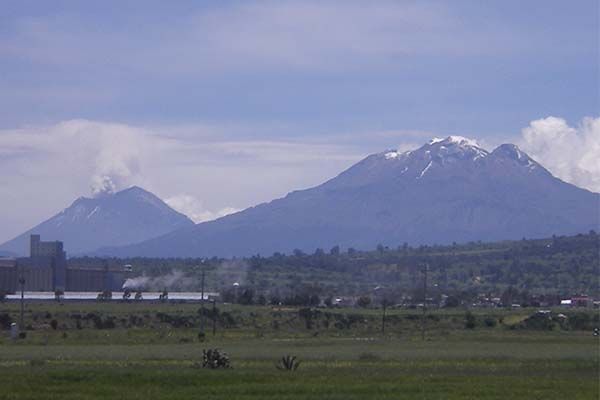The last permafrost and the extinction of Mexican glaciers
Glaciers in Mexico form in areas above five thousand meters, such as the volcanoes Popocatépetl (smoking mountain), Iztaccíhuatl (sleeping woman), and Citlaltépetl (star mountain or Pico de Orizaba).

A glacier is a compact mass of ice that has dynamics of growth and loss derived from solid precipitation such as snow, hail, and blizzards, unlike polar ice masses, altitude and latitude factors are also involved. Glaciers in Mexico form in areas above five thousand meters, such as the volcanoes Popocatépetl (smoking mountain), Iztaccíhuatl (sleeping woman), and Citlaltépetl (star mountain or Pico de Orizaba).
Popocatepetl is located at 5,420 meters above sea level, which favors the conservation of the glaciers, but its high eruptive activity ended up extinguishing them or burying them under ash. According to the last inventory carried out by glaciologists in 1996, the volcano had two perennial ice masses called "ventorrillo" and "noroccidental".
Citlaltépetl has a height of 5,670 meters and had four glaciers that covered an area of 9.5 square kilometers in 1958. As a result of global warming, their melting and retreat accelerated, and consequently, their number was reduced to two areas called: the North and the small Northwest. Scientists' projections are not encouraging, it is estimated that its life span will be two to three decades more.
While Iztaccihuatl, located at an altitude of 5,240 meters, had 12 glaciers, which were documented in 1958 by archaeologist José Luis Lorenzo, by 1982 the "neck", "west-northwest", "southeast" and "San Agustín" glaciers had disappeared, representing 16 percent less of the glaciated area of the volcano.
Ayoloco is the compound of three Nahua words: Atl, water; Yólotl, heart and Co, place; its meaning is "The place of the heart of the water".
Before 2018 "The sleeping woman" had five glacial zones located in the chest, stomach, and three in the southeast. After taking satellite photographs to monitor the area, scientists discovered that the perennial ice in the central zone ceased to exist.
The glacier named in Nahuatl "The place of the heart of the water" was officially declared extinct. Currently, Iztaccihuatl has three bodies whose surface area does not exceed 0.6 square kilometers, incomparable to the 6.23 kilometers recorded in 1850.
The fate of the last Mexican glaciers
According to Dr. Numa Pompilio Pavón Hernández, the disappearance of these areas has negative impacts on the planet, an example of this is in the albedo effect; the glacier reflected a large amount of energy to the atmosphere, but when the snow disappears, this light begins to be absorbed by the stones of the mountain generating a change in temperature in the area, which has repercussions on biodiversity.
"Possibly the loss of glaciers could generate extinction of some species in the peaks or a replacement of diversity by species more tolerant to high temperatures," said the climate change specialist.
During the different cycles of glaciations in Mexico, glaciers were generated in low areas such as the Ajusco, located in the State of Mexico, which upon entering a period of thawing gave rise to several water systems. The disappearance of these areas, snow, and ice systems could directly affect the supply of groundwater, lakes, and subway rivers.
"These are clear and resounding evidence of global warming, we are witnessing facts derived from climate change such as the extinction of glaciers in Mexico," stated the researcher.
Solid precipitations in the high peaks of volcanoes will continue to occur, such accumulation will generate runoff and will provide the snowy winter landscapes to which the population is accustomed, but they will not form new glaciers because the snow that accumulates contains too much air, which prevents the constitution of those compact masses of ice that give rise to glaciers.
For the formation of these areas it is necessary a series of climatological conditions that allow cold temperatures for long periods, in this way solid precipitations are favored, the problem is that the high-temperature increases melt the ice and hail that is just being formed.
Glaciers: evidence of global warming
According to data from the National Water Commission (Conagua), Mexico's average temperature has increased by two degrees Celsius in the last 35 years. In 2020 alone, Mexico registered a new historical record with a national average of 22.4 degrees Celsius, placing it together with 2017 and 2019 as the warmest year since 1953; while globally, the planet's temperature was 1.2 °C above the pre-industrial level, that is, in the period from 1850 to 1900, informed the World Meteorological Organization.
Dr. Pavón Hernández expressed his concern about the possibility of a late response to stop the effects of climate change, he recalled the situation of climate refugees and deaths due to famine in Africa, which resulted from the drought that hit the continent in the sixties and seventies of the last century.
"No one wants to hit bottom implies the death of a high percentage of the world's population if we do nothing, unfortunately, these scenes can be repeated and not in countries so far away," stressed the ICBI professor.
For this reason, the researcher considers that it is necessary to implement proactive actions that have a direct impact on the resolution of the climate change problem, however, these measures must be on a global scale and simultaneous.
According to Pavón Hernández, the dynamics of world governments is to act reactively to this phenomenon, that is, to implement mitigation programs once we have already been affected by the effects (hurricanes, forest fires, droughts, or floods) of climate change.
Source: Alejandra Zamora Canales, Gaceta UAEH




